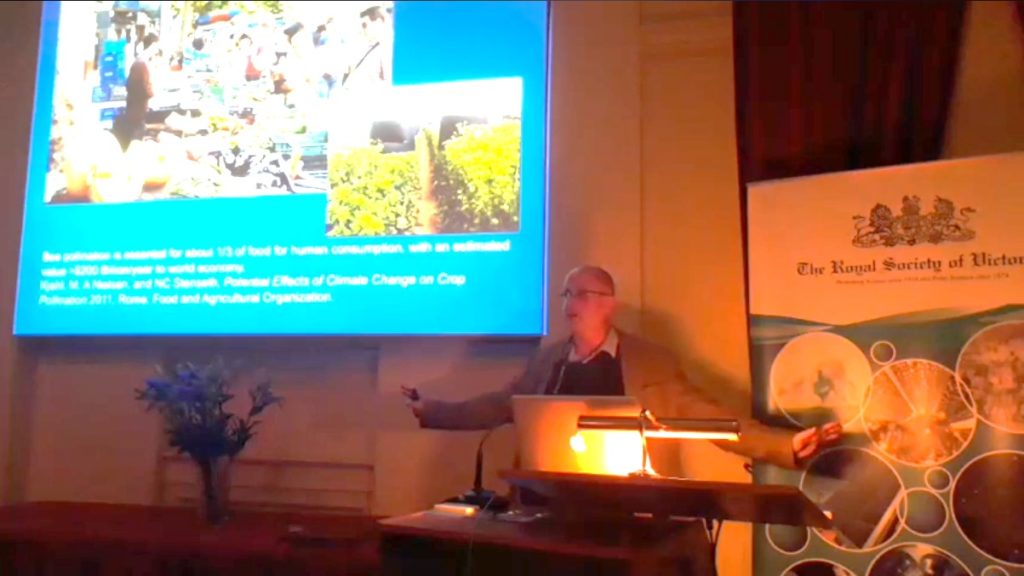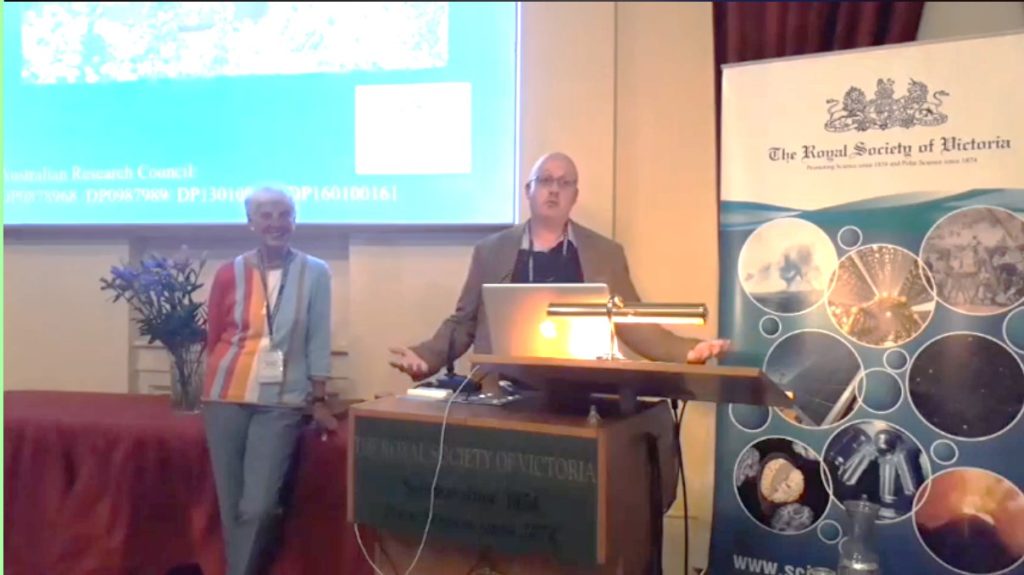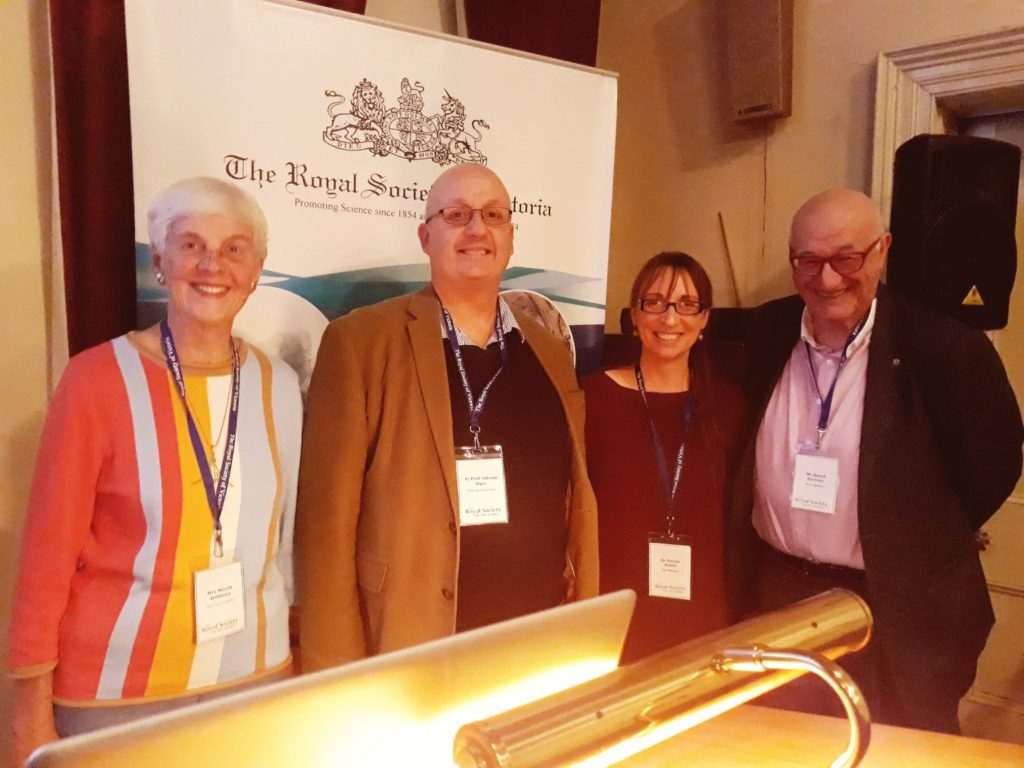One, Two, BEE
 By Catriona Nguyen-Robertson MRSV
By Catriona Nguyen-Robertson MRSV
This article follows a presentation to the Royal Society of Victoria on 23 May 2019 titled “Are bees smart pollinators? You can count on it!” featuring vision scientist Associate Professor Adrian Dyer from RMIT University.
One third of the world’s food production depends on bees – they are the world’s most important pollinator. Effective pollination by bees increases yield and improves the quality of agricultural produce, increases their resistance to pests, and preserves ecological balance and biodiversity in nature. The United Nations declared the 20th of May as World Bee Day to remind people of the importance of bees, and the Royal Society of Victoria hosted a lecture in their honour.

Bees are more intelligent than you might think. Associate Professor Adrian Dyer is interested in how the miniature brain of a bee can perform complex cognitive thinking. As a vision scientist and photographer, he seeks to understand how the representation of an image is created. In school, he was encouraged to pursue maths and arts by his teachers, and so he decided to study a bit of both in photography. Now he uses science as a way of problem solving and investigating visual perception at the RMIT School of Media and Communication.
While we may now take it for granted that other animals see colour, up until the last century, colour was only believed to be an aspect of human perception alone. The brains of bees are comprised of 960,000 neurons and are the size of a sesame seed. The human brain is 20,000 times bigger, and therefore insects were thought to have constrained neural processing capabilities in comparison. But 100 years ago, Nobel Laureate, Karl von Frisch changed this mindset: he showed that bees indeed have colour vision by training honeybees to collect a sucrose sugar solution associated with coloured cards, and they continued to return to the same coloured cards in the absence of sucrose. Since then, we’ve learned that bees can even perceive ultraviolet wavelengths, which are beyond what we can see.
To study how honeybees learn, Dyer made use of their ability to distinguish and learn through colour. He built learning arenas adjacent to bee hives, in which each bee is individually numbered. Individual bees enter the learning arena where they are trained and tested with various tasks and they receive sucrose as a reward for learning.
How do bees find flowers to pollinate?

The lens of a human eye focuses light onto the retina to perceive a sharp image, whereas bees have compound eyes that have many light-guiding tubes. Imagine looking through thousands of straws instead of looking clearly at an image. Sue Williams, Dyer’s student built a “bee camera” to simulate how bees see.
You may wonder how they even find flowers despite their poor vision. The answer is in their different perception. In fact, beautiful flowers didn’t evolve for our eyes, but for the eyes of bees and their pollinators.

In a collaboration with botanist Dr Mani Shrestha, Dyer assessed the colours emitted by flowering plants. Across the globe, even though different plant species evolved based on their drastically different environments, they all evolved their colour signals in parallel for their bird and bee pollinators. From Australia to Norway, and to the top of the Himalayas (and Dr Shrestha had to trek up the mountains with his laboratory on his back to sample the data), all flowers provide colour signals similar light range. Dyer wondered how plants might differ in the absence of bees. The only place he found to answer this question was Macquarie Island in the Pacific Ocean, where no bee has ever been and the only pollinators are flies, which see different wavelengths of light – and the flower colour signals reflected this.
The cognitive ability of bees
Not only are bees able to perceive colour, but Dyer also trained them to discriminate between and recognise images of human faces. He also taught them to learn size relationships (bigger or smaller), which even machine vision can struggle with. For example, when you teach a child the difference between a big and small cup, if you point out two mountains, the child would probably recognise that one is a smaller mountain, even though it’s bigger than the big cup.

Anyone who has seen honeycomb appreciates that bees understand geometry, but now they can even count and do arithmetic. Dyer has become a maths teacher for his bee pupils. He first recognised their mathematical ability when they recognised the concept of zero. When testing whether bees could determine which number was smaller of two (e.g. 5 or 2), they flew to the correct number. When he asked between 1 and nothing, the bees registered that nothing was smaller than one. This may seem trivial, but the mathematical zero and recognition of nothingness mathematically only appeared in the human record around 3 B.C. and reached Western Europe in the 12th century.
The next step was to determine whether bees can count and perform simple arithmetic. At first Dyer had no success, but perhaps he was going about it the wrong way. Mathematics uses a language that needs to be taught: “+” and “-” mean little to a bee. To bypass the communication issue, he used colours instead, with blue meaning “add one” and yellow meaning “subtract one”. When bees were put in a “maths maze” and asked to add or subtract shapes, they found the right path by correctly answering the questions and were rewarded with sucrose. This demonstrates the cognitive power of bees and their potential to learn.

We’re only just starting to understand how bees see the world. Dyer is employing the ability of bees to respond so well to colour to design more productive environments for agriculture that guide bees (effectively adding shopping aisle labels) so that they can better pollinate the crops. He also wants to mimic their biology in technology: ‘Machines use a lot of energy to perform computational tasks. Our brains work on a sandwich. Bees can work on a single drop of nectar.’ With increasing experience and understanding, there are many potential applications for this work, including robotics or building interfaces between sensors and biological systems.
A livestream video recording of A/Professor Dyer’s presentation can be viewed online at https://www.facebook.com/royalsocietyvictoria/videos/vl.2282388202000129/447410709402465








